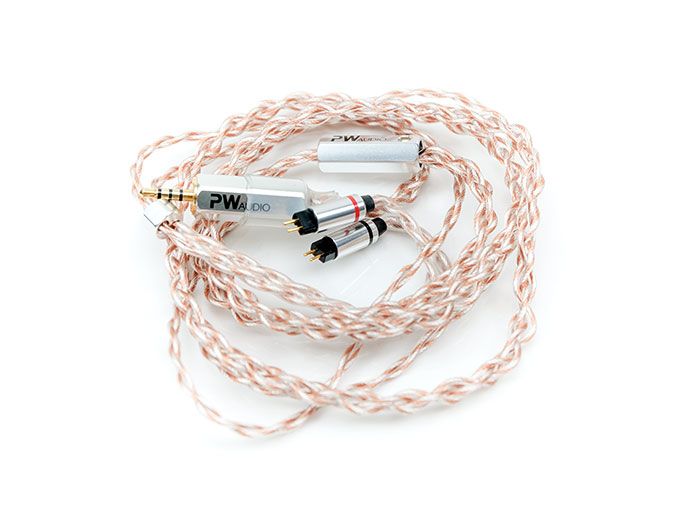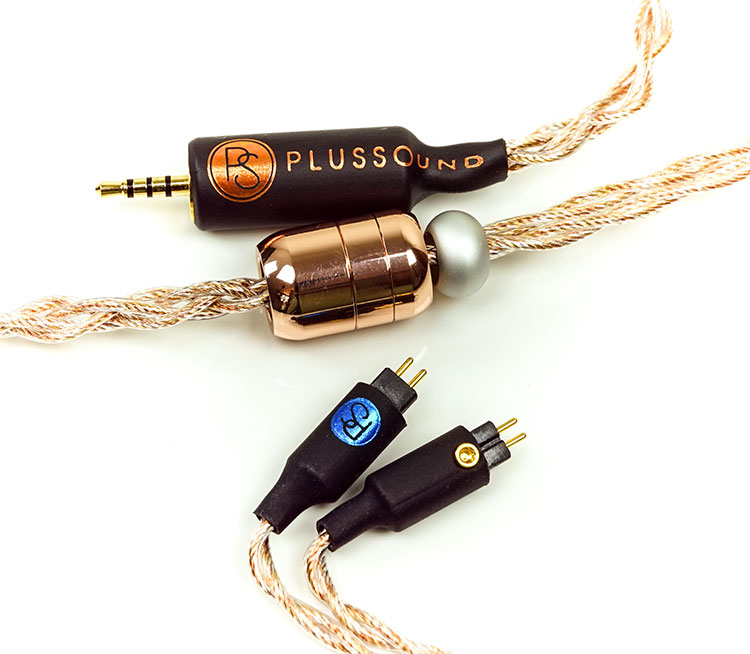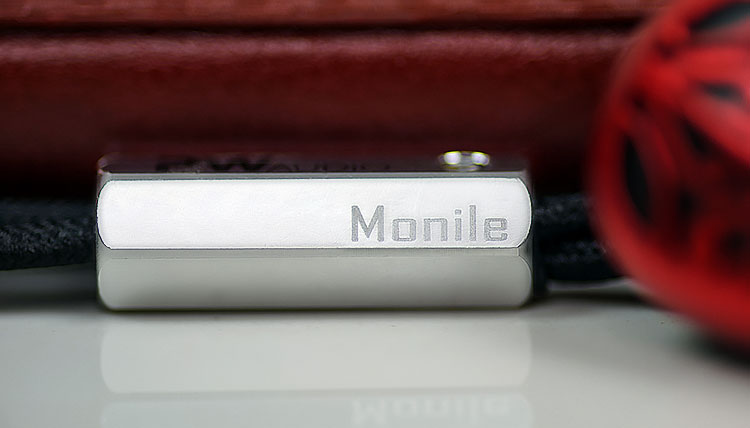Synergy
We tested a few monitors of various configurations with the Monile. This included 64 Audio’s Nio and Trio, as well as the new MMR Gae Bolg, ItsFitLabs weighty Fusion custom monitor, and the Andromeda 2020.
None of these pairings felt ill-matched and it will come down more to personal preference or comparative listening sessions with other competition cables.
An example of this is the Andromeda 2020 which sounded very clean, well-controlled, and nicely separated. Nothing spicey or grating in the treble as I had hoped it would be. However, the mids felt a little tame when compared to the fuller Cleopatra midrange sound which seemed to attack the stock sound signature of the Andromeda with a bit more gusto.
However, with the similarly all BA configuration of the Gae Bolg, I felt the Monile was the better pairing with less mid-bass bloom, a cleaner midrange, and generally a peppier treble performance. Horses for courses as they say.
The hybrid duo from 64 Audio did particularly well with the Monile’s penchant for excellent sub-bass performances. Both of these got a nice kick in the rear, not so much in quantity but rather in the definition.
The Trio already has an excellent dynamic driver sub-bass timbre and the Monile took nothing away from that. If anything, it offered a bit more ‘drive’ or PRaT without any annoying bloom.
Select Comparisons
PWAudio “Vanquish” Saladin
$339
Technical
We did a quasi-review of the Saladin last year in relation to the Lark Studio LSXC custom monitor which offered it as an upgrade cable. The Saladin retails a little cheaper than the Monile and is part of a wider Triple Vanquish range of PW Audio cables including the Xerxes and Loki options.
The geometry of these two cables is hugely different. The Saladin uses a much smaller gauge but a lot more bundles of it. This is a 7-bundle Litz geometry of 4 groups of deoxygenated copper and 3 groups of extruded and deoxygenated silver-plated copper in a 4-wire 34AWG build using a clear PVC jacket.
By contrast, the Monile geometry seems much simpler though no less unique with its 4-core 26AWG ultra-purity copper and 25.5AWG super-purity silver and a positive and negative conductor design with 2 positive conductors and 2 negative conductors as the cable’s shielding.
Design
The Saladin has quite a different design and borrows more heavily from current clear PVC jacket stylings used by the likes of Effect Audio and PLUSSOUND. That means the mixed-use of copper and SPC is very visible to the naked eye compared to the all-black finish of the nylon jacketed Monile.
However, both do have a very similar silver tone to their finishing with the aluminum hexagonal long-barrel splitter and slightly larger similarly designed jack barrels. The connector barrels are also exactly the same, (if you are opting for 2-pin), as the low-profile aluminum chin cinch.
Despite the different jacket materials both cinch’s hold their position quite well though to be fair the Saladin version feels a little grippier. The one bonus of this version of the Monile that I have is the lack of transparent heat shrink wrap on the bottom half of the jack barrel. The Saladin has that and it does give it a slightly DIY feel to the design which I am not in favor of.
You do have a few termination options on the Saladin, much like the Monile, such as 2.5mm TRRS, 3.5mm TRS, and 4.4mm. The barrel finish on the Saladin is PW Audio’s distinctive hexagonal silver finish aluminum with matching chin cinch and round chrome finished 0.78mm 2-pin terminations.
Handling is a mixed bag between these two with the Monile, overall, the tidier finish and less memory retentive. However, the Saladin does seem to be marginally quieter above the splitter for microphonics.
Performance
The Saladin is more linear for me compared to the Monile. Linear in the sense it has a flatter low-end response and a tamer treble from our tested monitors. The Monile is more vibrant, heavier on the sub-bass response, lighter on the mid-bass bloom, and cleaner on the mids. It was also ‘peppier’ on the treble articulation.
I actually found that hybrids or dynamic driver monitors showed up the differences a lot quicker compared to BA IEMs such as the Gae Bolg, perhaps due to how the Monile really attacks that sub-bass response. Balanced armature configurations delivered more of the Monile’s vibrancy on the upper mids and treble.
The Saladin tended to stay within that very linear curve and sounds comparatively relaxed in its mids and treble. For dynamic driver low-ends, such as the 64 Tio Trio the Saladin tended to shift more to an even to slightly mid-bass bias with some bloom there but not quite the deep ‘bounce’ as I like to call it when the sub-bass is pulled in.
That means a better perception of power and space with improved staging depth pairing with the Monile. You also get more treble extension and forwardness. The Saladin will tail off a little at the extremes though not by much and has more of a reference but shallower midrange performance on the Tia Trio and Gae Bolg.
Effect Audio Cleopatra
$699
The Cleopatra is the third cable entry in Effect Audio’s Heritage Series alongside the Lionheart and Leonidas II. The Heritage Series is where Effect Audio engineer “on the edge’ so to speak.
In short, they take a few risks, try something new and bring out a product that they think is genuinely unique as well as groundbreaking in the cable industry. Kind of their ‘blue sky’ thinking line-up.
Technical
Both cables use a 4-core 26AWG wiring but that is where the similarities end. The Cleopatra uses a very high grade of UP-OCC Pure Silver with a woven Kevlar core into the geometry build to keep this grade of silver stabilized and working optimally.
The geometry is a Litz build with 7 cores, (much like the Saladin), with individually enameled strands and faithful adherence to the golden ratio for the layering of the wires within the Litz build.
That is a big contrast to the split 26AWG ultra-purity copper and 25.5AWG super-purity silver in the Monile. Both wires are aligned in a positive and negative conductor geometry with 2 positive conductors and 2 negative conductors as the cable’s shielding.
Design
Oh boy, a huge difference almost like the light vs the dark side of the force. The Cleopatra is a radiant silver through and through with its transparent UltraFlex PVC jacket, matching chrome silver connectors and splitter, as well as a carbon printed jack barrel.
The Monile is all black with its cotton soft jacket versus the translucent PVC of the Cleopatra creating a very different handling experience. The Cleopatra has the classic short-throw tight braid that EA are known for but the Monile is even tighter albeit a bit stiffer as a result.
The Monile does have a passing resemblance in the use of a chrome silver finish on the terminator and splitter barrels. However, the form factor is very different with the Cleopatra using a stubbier but wider round barrel compared to the slimline but longer hexagonal screw finish of the Monile splitter.
The Cleopatra terminator barrels are also a little stubbier with channel labeling that is not as legible as the red and black rings of the Monile version. The jack bases are the same diameter on both cables but the barrel of the Monile does not have that nice little curved closer to the rear of the Cleopatra.
I have to give props to Cleopatra’s handling. Below and above the splitter, it is the quieter of the two cables for microphonics. However, both have next to no memory retention, and if anything that slightly stiffer quality of the Monile shades it for a lack of kinks.
Performance
The Cleopatra is the fuller sounding of the two 4-wire cables with a richer tone from the mid-bass through to the lower-treble. By contrast, the Monile has a more neutral effect on our tested monitors through the mids and a livelier treble.
That means notes are a little cooler in timbre on both the Gae Bolg and 64 Audio Trio using the Monile and definitely wetter and warmer when switching to the Cleopatra.
However, the low-end or sub-bass response on the Monile has a bit more impact and definition and a slight dominance with a weaker mid-bass influence, especially on the Trio’s dynamic driver.
That means if the sub-bass region is not called when paired with the Monile it can seem lighter in terms of weight and body compared to the Cleopatra. When it digs deep though you get a more palatable sense of power over warmth and a bit more bass to mids separation.
Both cables image very well in the mids with a clear vocal presence on both the Gae Bolg and 64 Audio Trio with that timbral change up making the difference. However, it might seem that the Cleopatra brings out a bit more mids presence but going back and forth it’s more about the timbre richness and body rather than imaging.
The Monile has a bit more treble energy and less mid-bass bloom so it trends to ween a bit of warmth out of vocal and instrumental timbre and give a cleaner sound hence that perception described above.
Plussound Tri-copper (Exo)
$549
Technical
The Tri-Copper (Exo version) from PLUSSOUND is similarly priced but with a very different mix of materials. For reference purposes, PLUSSOUND can create a wide range of finishes on their cables so the version we have here is but one of many though the geometry and jackets are fixed.
The Tri-Copper uses three different mixes of copper: UP-OCC copper, silver-plated copper, and gold-plated copper, all in a single 26AWG Type 6 Litz configuration. The Monile uses a mix of copper and silver though on separate wires with 26AWG copper and 25.5 AWG silver. Both I presume to be also UP-OCC with that 2 wire coaxial negative and positive alignment.
Design
Again, like the Cleopatra, the Tri-Copper is a hugely different looking cable and also handles a bit differently. The use of a clear PVC jacket means you get a hefty copper shiny tone from the aesthetics of the cable compared to the subdued black and soft cotton look of the Monile.
That coppery tone is accentuated by a short but very bulbous rose gold splitter and black heat shrink wrapped jack and termination barrels. The PW Audio route is a little more execute for me with those slimline aluminum barrels and splitters so not the high impact look but perhaps more nuanced.
Note, PLUSSOUND has upgraded some of their components since we received this Tri-Copper cable sample so, the heat shrink cover on the jacks and connectors has now been replaced by some very refined chrome aluminum stems such as you will find on their newer X6 Palladium-Plated Hybrid Cable.
Like the Cleopatra, the Tri-Copper handling is just a little bit easier for me than the Monile with less microphonics above the splitter and a more supple handling experience. I suspect that the cotton jacket might be the culprit here above the splitter has the friction noise is a bit more noticeable.
However, as with the Cleopatra comparison, the Monile unfurling experience is much tidier so it looks a little bit tidier with less potential kinks and twists.
Performance
This is one of those comparisons where you can tell that one cable is all copper in the traditional sense and the other has a lick of silver in it. The key difference here is in the mid-bass performance and the amount of lower-treble presence and air.
The Tri-copper has almost the same weighted sub-bass response as the Monile but it is a little softer and not quite as well defined. This is partly due to how it teases out the mid-bass on both the Bae Bolg and 64 Audio Trio. In short, you get a lot more warmth with the Tri-Copper.
On both monitors, the Tri-Copper has more mid-bass bloom and a richer mids timbre as a consequence. It plays out well with the Trio, less well for the warmer stock sound of the Gae Bolg. With the Monile pairing, both monitors have the same bass weight and response but less mid-bass bloom and a more neutral mids timbre.
The Monile also has a bit more treble presence that helps keep the mids timbre cleaner and airier through to the lower-treble on both monitors. However, it is the Gae Bolg that benefits more with the Monile as its 2-4k dip needs spicing up a little more for me. The Tri-Copper can overly thicken it which is not ideal and sits much better with the airier cleaner Trio pairing.
Our Verdict
The PW Monile is a unique sounding cable that will appeal to those who want to produce a cleaner sound or produce a bit more depth and definition to both ends of the spectrum, namely sub-bass, and treble.
This is not a reference sounding cable, and not as linear as its sibling, the Saladin. There is a degree of vibrancy and energy that makes it a more ‘exciting’ sounding proposition. The Monile sounds excellent with dynamic driver hybrids where PRaT is key without the accompanying mid-bass bloom or congestion.
It still retains that classic PW Audio ‘executive’ vibe in terms of design with their signature black soft cotton jacket finish and silvery hexagonal barrels. That’s an old-school charm for me, some will like it, others might prefer the pop of transparent PVC cables allowing the wire to shine through.
Overall, this is a competitive cable, a memorable tweak in terms of tuning with some of my favored IEMs, and distinctly different from some of the competing offerings within the same price range.
PW Audio Monile Specifications
- Jacket Material: PVC, soft FEP, Cotton
- Conductor Material: Ultra purity Copper and super purity silver
- Conductor Gauge: 26awg copper and 25.5awg silver
- No. of Conductor: 4, (2 Positive Conductor and 2 negative Conductor as shielding)






